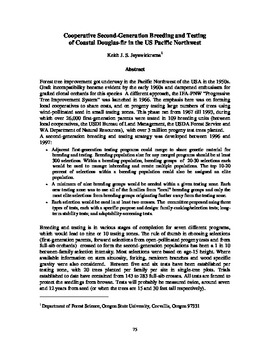| dc.contributor.author | Jayawickrama, K. J. S. | |
| dc.date.accessioned | 2016-04-25T19:35:58Z | |
| dc.date.available | 2016-04-25T19:35:58Z | |
| dc.date.issued | 2003 | |
| dc.identifier | oksd_sf27_p075.pdf | |
| dc.identifier.citation | Jayawickrama, K. J. S. (2003). "Cooperative Second-Generation Breeding and Testing of Coastal Douglas-fir in the US Pacific Northwest." In 27th Southern Forest Tree Improvement Conference, Stillwater, OK | |
| dc.identifier.uri | https://hdl.handle.net/11244/33665 | |
| dc.description.abstract | Forest tree improvement got underway in the Pacific Northwest of the USA in the 1950s. Graft incompatibility became evident by the early 1960s and dampened enthusiasm for grafted clonal orchards for this species A different approach, the IFA-PNW �Progressive Tree Improvement System� was launched in 1966. The emphasis here was on forming local cooperatives to share costs, and on progeny testing large numbers of trees using wind-pollinated seed in small testing zones. This phase ran from 1967 till 1993, during which over 26,000 first-generation parents were tested in 109 breeding units (between local cooperatives, the USDI Bureau of Land Management, the USDA Forest Service and WA Department of Natural Resources), with over 3 million progeny test trees planted. A second-generation breeding and testing strategy was developed between 1996 and 1997: Adjacent first-generation testing programs could merge to share genetic material for breeding and testing. Breeding population size for any merged programs should be at least 300 selections. Within a breeding population, breeding groups of 20-30 selections each would be used to manage inbreeding and create multiple populations. The top 10-20 percent of selections within a breeding population could also be assigned an elite population. A minimum of nine breeding groups would be needed within a given testing zone. Each new testing zone was to use all of the families from "local" breeding groups and only the most elite selections from breeding groups originating further away from the testing zone. Each selection would be used in at least two crosses. The committee proposed using three types of tests, each with a specific purpose and design: family-ranking/selection tests; longterm stability tests; and adaptability-screening tests. Breeding and testing is in various stages of completion for seven different programs, which would lead to nine or 10 testing zones. The rule of thumb in choosing selections (first-generation parents, forward selections from open-pollinated progeny tests and from full-sib orchards) crossed to form the second-generation populations has been a 1 in 10 between-family selection intensity. Most selections were based on age-15 height. Where available information on stem sinuosity, forking, ramicorn branches and wood specific gravity were also considered. Between five and six tests have been established per testing zone, with 20 trees planted per family per site in single-tree plots. Trials established to date have contained from 143 to 283 full-sib crosses. All tests are fenced to protect the seedlings from browse. Tests will probably be measured twice, around seven and 12 years from seed (or when the trees are 15 and 30 feet tall respectively). | |
| dc.format | application/pdf | |
| dc.language | en_US | |
| dc.relation.ispartofseries | Sponsored publication . . . of the Southern Forest Tree Improvement Committee ; no. 49 | |
| dc.rights | This paper is made available through open access and the auspices of the fair use doctrine for scholarly, educational and research purposes while recognizing the publisher already offers a free online version. The OSU Library�s intent is to offer access and preserve publications involving its faculty contributions. Contact the Digital Resources and Discovery Services at lib-dls@okstate.edu or 405-744-9161 for the permission policy on the use, reproduction or distribution of this material. | |
| dc.source | Proceedings of the 27th Southern Forest Tree Improvement Conference, volume 27, 2003. Editor, Craig R. McKinley. | |
| dc.title | Cooperative Second-Generation Breeding and Testing of Coastal Douglas-fir in the US Pacific Northwest | |
| dc.type | text | |
| osu.filename | oksd_sf27_p075.pdf | |
| dc.type.genre | Conference proceedings | |
| dc.description.scopeandcontents | Papers and abstracts from the 27th Southern Forest Tree Improvement Conference held at Oklahoma State University in Stillwater, Oklahoma on June 24-27, 2003. | |
